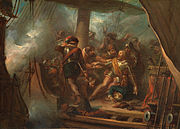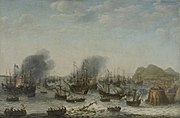Battle of Gibraltar (1607)
This article includes a list of generalreferences,butit lacks sufficient correspondinginline citations.(April 2014) |
| Battle of Gibraltar | |||||||
|---|---|---|---|---|---|---|---|
| Part of theEighty Years' War | |||||||
 Battle of GibraltarbyCornelis van Wieringen | |||||||
| |||||||
| Belligerents | |||||||
|
|
| ||||||
| Commanders and leaders | |||||||
| Jacob van Heemskerk† | Juan Álvarez de Avilés† | ||||||
| Strength | |||||||
| 26 warships |
| ||||||
| Casualties and losses | |||||||
|
| ||||||
The navalBattle of Gibraltartook place on 25 April 1607, during theEighty Years' War,when a Dutch fleet surprised and engaged a Spanish fleet anchored at theBay of Gibraltar.During the four hours of action, most of the Spanish ships were destroyed.
Forces
[edit]A Dutch fleet of 26 warships was led by AdmiralJacob van Heemskerk.The Dutch flagship wasÆolus(of the Zeeland Admiralty). Other Dutch ships wereDe Roode Leeuw(also of the Zeeland Admiralty, and flagship of Vice-Admiral Laurens Jacobszoon Alteras),De Tijger(of the Maas Admiralty, and flagship of Rear-Admiral Lambert Hendrikszoon),De Zeehond,De Griffioen,De Gouden Leeuw,De Zwarte Beer,De Witte Beer,andDe Ochtendster.
A Spanish fleet of 21 ships, including 10galleons,was led by Don Juan Álvarez de Avilés. The Spanish flagshipSan Augustinwas commanded by Don Juan's son. Other ships wereNuestra Señora de la VegaandMadre de Dios.The Spanish fleet was covered by a fortress, although the Dutch fleet was out of range of its guns at all times and the fortress guns were not able to affect the battle.[1]
Battle
[edit]
Van Heemskerk left some of his ships at the bay entrance to prevent the escape of any Spanish ships. Twenty from the Dutch fleet were ordered to focus on the Spanish galleons while the rest attacked the smaller vessels.[2]Van Heemskerk was killed during the first approach on the Spanish flagship as acannonballsevered his leg. The Dutch then doubled up on the galleons and a few of the galleons caught fire. One exploded due to a shot that penetrated its powder magazine. The Dutch captured the Spanish flagship but let it go adrift.
Following the destruction of the Spanish ships, the Dutch deployed boats and killed hundreds of swimming Spanish sailors. The Dutch lost 100 men including Admiral Van Heemskerk. Sixty Dutch were wounded. Depending on the sources, most or all of the Spanish ships were lost and between 350 and 4,000 Spaniards were killed or captured. Álvarez de Avilés was amongst the dead.
Consequences
[edit]The battle was a leading driver of theTwelve Years' Truce,under which the Dutch Republic achievedde factorecognition by theSpanish Crown.
The battle had an important indirect effect on theHistory of Ireland,specifically the key event known as "Flight of the Earls".Hugh O'Neill, 2nd Earl of Tyrone,andRory O'Donnell,1st Earl ofTyrconnell,leftUlsterin Ireland with the intention of getting a Spanish army to invade Ireland on their behalf. The destruction of the Spanish fleet ruled out any such option, and the Earls found themselves in irrevocable exile – with major consequences for the later history of Ireland, and especially of Ulster.
Gallery
[edit]Footnotes
[edit]Sources
[edit]- Fernández, C. (1898).Armada Española desde la unión de los reinos de Castilla y Aragón(in Spanish). Madrid: Rivedeneyra.
- Vere, F. (1955).Salt in their Blood: the lives of the famous Dutch admirals.
- De Jonge, J. C.Geschiedenis van het Nederlandse zeewezen(in Dutch).
- Akveld, L. M.; et al. (1973).Vier Eeuwen Varen(in Dutch).
- Warnsinck, J. C. M.(1941).Twaalf Doorluchtige Zeehelden(in Dutch).
External links
[edit] Media related toBattle of Gibraltar (1607)at Wikimedia Commons
Media related toBattle of Gibraltar (1607)at Wikimedia Commons





